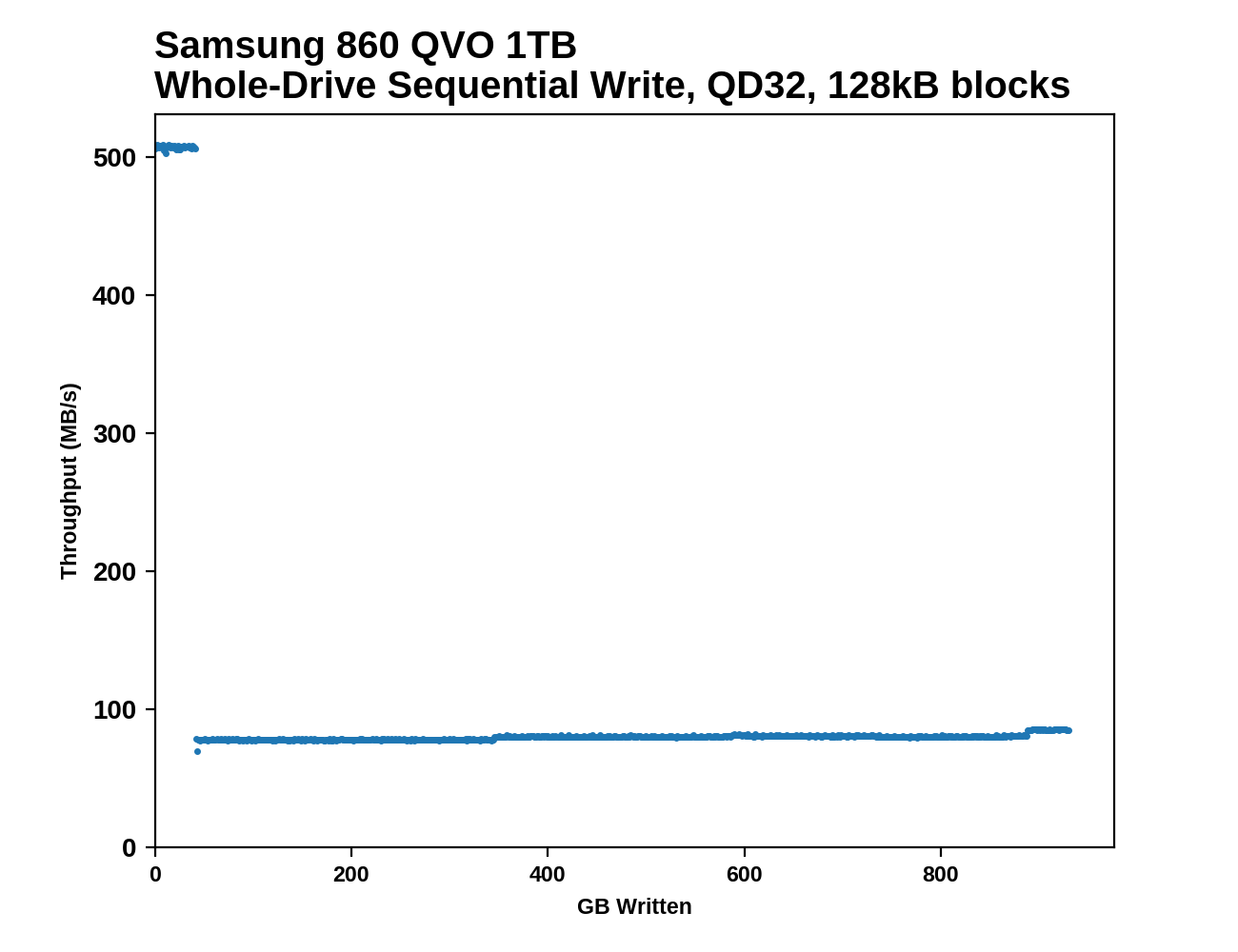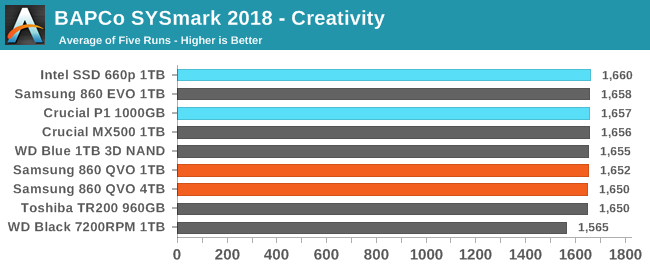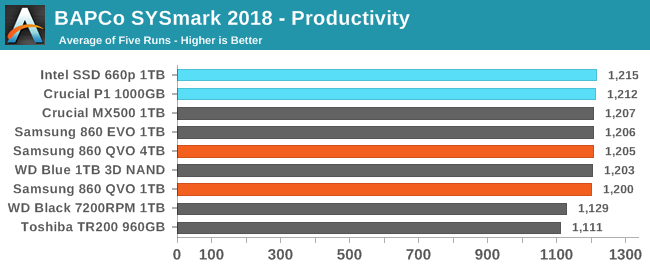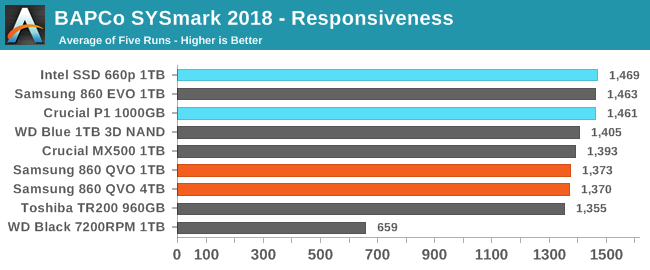The Samsung 860 QVO (1TB, 4TB) SSD Review: First Consumer SATA QLC
by Billy Tallis on November 27, 2018 11:20 AM ESTWhole-Drive Fill: Testing SLC Cache Size
This test starts with a freshly-erased drive and fills it with 128kB sequential writes at queue depth 32, recording the write speed for each 1GB segment. This test is not representative of any ordinary client/consumer usage pattern, but it does allow us to observe transitions in the drive's behavior as it fills up. This can allow us to estimate the size of any SLC write cache, and get a sense for how much performance remains on the rare occasions where real-world usage keeps writing data after filling the cache. Samsung's official specifications are:
| Samsung 860 QVO Secondary Specifications | |||||
| Capacity | 1 TB | 2 TB | 4 TB | ||
| SLC Cache Size |
Min | 6 GB | 6 GB | 6 GB | |
| Max | 42 GB | 78 GB | 78 GB | ||
| Sequential Write |
SLC Cache | 520 MB/s | |||
| QLC | 80 MB/s | 160 MB/s | 160 MB/s | ||
Our results show the following:
 |
|||||||||
The Samsung 860 QVOs run out of SLC cache right on schedule, at 42 GB for the 1TB model and 78 GB for the 4TB. After that, they are both slow and very steady for the rest of the test.
 |
|||||||||
| Average Throughput for last 16 GB | Overall Average Throughput | ||||||||
The 1TB 860 QVO falls below the sequential write speed of a 1TB hard drive once the SLC cache runs out, but the 4TB model is able to sustain twice the write speed and remains ahead of not just the hard drive's speed, but also some of the slower TLC drives.
BAPCo SYSmark 2018
BAPCo's SYSmark 2018 is an application-based benchmark that uses real-world applications to replay usage patterns of business users, with subscores for productivity, creativity and responsiveness. Scores represnt overall system performance and are calibrated against a reference system that is defined to score 1000 in each of the scenarios. A score of, say, 2000, would imply that the system under test is twice as fast as the reference system.
SYSmark scores are based on total application response time as seen by the user, including not only storage latency but time spent by the processor. This means there's a limit to how much a storage improvement could possibly increase scores, because the SSD is only in use for a small fraction of the total test duration. This is a significant difference from our ATSB tests where only the storage portion of the workload is replicated and disk idle times are cut short to a maximum of 25ms.
| AnandTech SYSmark SSD Testbed | |
| CPU | Intel Core i5-7400 |
| Motherboard | ASUS PRIME Z270-A |
| Chipset | Intel Z270 |
| Memory | 2x 8GB Corsair Vengeance DDR4-2400 CL17 |
| Case | In Win C583 |
| Power Supply | Cooler Master G550M |
| OS | Windows 10 64-bit, version 1803 |
Our SSD testing with SYSmark uses a different test system than the rest of our SSD tests. This machine is set up to measure total system power consumption rather than just the drive's power.



The 860 QVO isn't any slower for compute-heavy interactive tasks than the mainstream SATA SSDs, and even on the more I/O-bound Responsiveness test the 860 QVO is ahead of the DRAMless TLC drive and not far behind the Crucial MX500.
Energy Use
The SYSmark energy usage scores measure total system power consumption, excluding the display. Our SYSmark test system idles at around 26 W and peaks at over 60 W measured at the wall during the benchmark run. SATA SSDs seldom exceed 5 W and idle at a fraction of a watt, and the SSDs spend most of the test idle. This means the energy usage scores will inevitably be very close. A typical notebook system will tend to be better optimized for power efficiency than this desktop system, so the SSD would account for a much larger portion of the total and the score difference between SSDs would be more noticeable.

The Samsung 860 QVO's energy usage during SYSmark is not a problem at all, with it using slightly less energy than the mainstream SATA TLC drives.










109 Comments
View All Comments
Morawka - Wednesday, November 28, 2018 - link
I just had 2 Samsung QLC 3 bit drives die this year alone. They were less than 1.5 year old. I'm never buying Samsung's EVO line again. It will be Pro from here on out. 4 bit drives will fail even faster.Makaveli - Wednesday, November 28, 2018 - link
Which model evo's were those Morawka?And how many writes did they see? what kind of environment did you have them in?
stephenbrooks - Wednesday, November 28, 2018 - link
I was starting to get excited about 2TB for $300 but then I looked up 2TB HDDs and they're about $60. Still a huge price differential especially as I usually want at least one extra drive for nightly backups, although perhaps the backup drive could be the HDD?Lolimaster - Thursday, November 29, 2018 - link
Even with the right capacities for a QLC price is similar or worse than current TLC.Samsunf 860 EVO 1TB $127
For QLC to make sense it should HALF of a TLC else is a ripoff.
s.yu - Friday, November 30, 2018 - link
What's the point of trying to pronounce it? It's just Q-V-O!araczynski - Friday, November 30, 2018 - link
so basically next black friday these should be half price and the 4tb might be worthy of consideration as a Steam drive.thomas-hrb - Friday, November 30, 2018 - link
$149.99 launch price is encouraging even if it is currently more than the 860evo. The 860evo launched for over $300 (closer to $330) and is now $139. If the qvo follows this pattern we can look forward to sub $65 for the 1tb qvo and maybe even $250 for 4tb.Ankou - Friday, November 30, 2018 - link
I think these QLC drives are a bad idea especially in the way they're being marketed. I'm not even talking about performance, the speed reduction I could live with. However, they're orders of magnitude worse in P/E cycles, retention, and endurance. These manufacturers know this and they're preying on the lack of education and focusing on price. Even so far as advertising these drives (this one in particular) as using 4 bit MLC memory (which 4 bit MLC is *always* QLC) implying that it is on safer MLC memory:https://news.samsung.com/global/samsung-electronic...
That is completely a scummy marketing/PR way of doing business.
s.yu - Saturday, December 1, 2018 - link
The fundamental issue is that 2-bit MLC should have been accurately named DLC in the first place, it's not like somebody's gonna mix that up with downloadable content.0ldman79 - Saturday, December 15, 2018 - link
Could we get some numbers from some mechanical drives, WD or Seagate 1TB or 2TB, in comparison to the slower QLC drives?I'd like to see how they hold up against the QLC in random and sustained reads/writes. The latency might be the deciding factor even though I've got some mechanical drives that can beat them on sustained reads/writes.